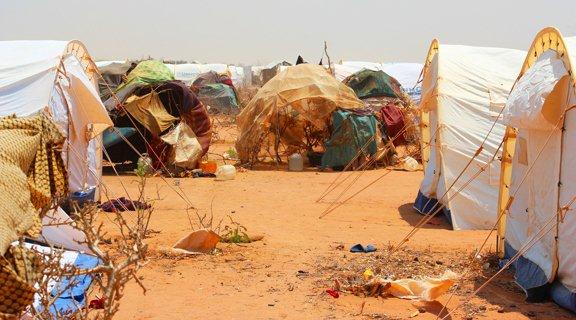Today, I spent the entire day at the Dadaab refugee camp on the Somali border. Now considered to be the largest refugee camp in the world, 25,000 people have already perished here, most of them being children. Perhaps one of the most tragic of these realities is that most Americans remain unaware of this ongoing crisis and are empowered even less to respond to its staggering magnitude.
Since our World Help team was traveling with the Deputy Speaker of Parliament and the Prime Minister’s personal assistant, we had a caravan of seven vehicles including United Nations workers and armed security accompanying us to Dadaab.
Seeing Dadaab for the first time did not compare to any photo or television report I have seen up to this point. The camp is massive and actually consists of three separate sub-camps spread out over an area spanning more than 20 square kilometers. Originally built to hold 90,000 refugees, Dadaab is now flooded with almost half a million desperate residents. The multitude continues to increase with an influx of more than 1,500 refugees arriving every day.

Conditions in the camp are abysmal. There is not enough water to meet even the most basic of needs. Physical hygiene is nonexistent. Makeshift latrines are few and far between, and the spread of disease is imminent.
We visited the registration area where hundreds of new arrivals were being processed. There were very few men, mostly women and children. Every family I saw carried at least one malnourished child. Nearly all of them had walked more than two weeks to get here, braving the unrelenting heat, wind, and sandstorms. I can’t imagine spending 14 days walking in these unbearable elements.
Each family was given a bag of rice, some cooking utensils, sleeping mats, and a blanket. Several families would load their only possessions on the back of a donkey cart and walk for several more hours, just to get to their tents. This tent would become a makeshift home for the evening and probably for many more nights to come—a meager and lonely shelter without much protection from the elements.
One of our first encounters of the day was with a mother who had just lost her six-month-old baby to measles. We could see that she had been weeping and I can’t begin to imagine the heartache she must be experiencing.
After this sobering meeting, we were given a brief tour of the Dadaab hospital where 190 children were dying from malnutrition, measles, and other preventable diseases. There were as many as 50 children in one room along with their mothers and nursing babies. When I spoke to a doctor, he confirmed that in the last 90 days, more than 30,000 children have died.
I walked to the back of one of the hospital wards where I saw a little boy about the same age as one of my grandchildren. He was suffering from the final stages of malnutrition and was only moments away from taking his last breath. Out of respect for his family, we did not take any photographs, but I will never forget that sight. There was nothing more the doctors could do; he was too far gone. What I saw and heard in those brief minutes has quickly become one of the saddest moments of my life.
We continued on, passing a makeshift cemetery with 55 recent shallow graves of children who had died here in Dadaab. Grieving mothers had placed tree branches over the graves to keep the hyenas from scavenging their remains.
As our caravan was driving down one of the dusty roads, a large crowd of over 100 refugees stopped our vehicle and begged me to get out and follow them. At first, I was afraid because the crowd was too big, and I was somewhat concerned for our safety. Then my eyes met with a mother who was crying and begging desperately.
Dismissing my fears, I stepped out of the vehicle and began to piece together her story with the help of a translator. Her name was Ablah, and as we walked toward her hut, I found out that she had just arrived that very day with her six children. Speaking in a raspy whisper, because of all the dust she had breathed along her journey, this woman told me it would take several days for her to be processed. She had no food and her voice shook as she whispered, “My two youngest children may not make it through the night.” Doing what little I could do to console her, I promised to go to the authorities on her behalf so that she received food and water before nightfall.
From this experience, I can honestly say that Dadaab refugee camp is indeed the most desperate place on earth. This crisis is without a doubt a humanitarian catastrophe. More than 3.2 million Somalis (2 million of them being children) are going to die in the next few weeks if they do not receive proper nutrition, clean water, and medical attention.
However, there is some good news. World Help has received a guarantee from the Kenyan government to expedite 20 secured containers of food (nearly 5 million meals) and $12.5 million of medicine through customs and into the hands of Somali refugees.
The cost for shipping these containers is approximately $6,000 each, for a total of $120,000 in all. Your generosity towards reaching this goal has been tremendous so far and I am truly grateful. Still, the Somali people need us to continue to reach out, more than we ever have before. Please consider going above and beyond by underwriting the cost of one of these containers as a family, church, or business.
We’ve tried to make giving as easy as possible. Click here to give online or call toll free 800-541-6691 to place a gift on your credit card. You can also donate $10 by texting WORLDHELP to 85944. Finally, to fundraise along with us, go to http://crisis.worldhelp.net.
I’ve never seen a crisis anywhere in the world where so little will do so much. Every container of food and medicine you help us send will literally save hundreds of lives. I have often said that every day I try to live my life in such a way that I accomplish at least one thing that will outlive me and last for eternity. Today in Dadaab, I realized that together we can do just that.
Please join me by responding today.
To view videos and photos from the field, visit our Horn of Africa campaign page or click here to read more on the continuing crisis in the Horn of Africa.




